
|

|
Forum Index : Solar : EV Hilux Lithium now Wind /Solar Lithium
| Page 1 of 2 |
|||||
| Author | Message | ||||
Trev Guru Joined: 15/07/2006 Location: AustraliaPosts: 640 |
The lithium bateries that have run my EV Hilux http://www.thebackshed.com/forum/forum_posts.asp?TID=5991&PN =1 are now running my house, sheds, health clinic, and feeding the excess power to the grid. I think it is great having a good set of batteries that don't really owe me anything, but still giving good service. The old lead acid batteries are the ones I first started with in the EV Hilux. Originally started with 13 of them, but have sold a few over the years. Of these 8 left, one of them is no good now and another possibly no good, but the other 6 seem to be OK. They will all be taken to the scrap though. Trev @ drivebynature.com |
||||
| VK4AYQ Guru Joined: 02/12/2009 Location: AustraliaPosts: 2539 |
Hi Trev That is some power house you are working on, hope you get the last bit of use out of the old batteries before scrapping them, a couple of desulphators will keep them wandering on for a few years doing some useful work even if it is only a bid of grid feed. All the best Bob Foolin Around |
||||
| powerednut Senior Member Joined: 09/12/2009 Location: AustraliaPosts: 221 |
has anybody had much experience with desulphators and lithium batteries? Do they work? |
||||
| M Del Senior Member Joined: 09/04/2012 Location: AustraliaPosts: 155 |
Hi Trev AS Bob said, nice power house. I have a question regarding the batteries you took out of the Hilux. You wrote that they may have been damaged by too deep a discharge when range testing. Is there also a possibility they were damaged when you hooked the generator up to it when you took the trip to the EV show? In that thread you wrote that you added ice to get the pack down to a decent temperature. If so, would it be reasonable to consider that excessive temperature is the reason for early failure of some of the cells. I am thinking of building an EV ute/wagon similar to yours and the use of an external generator would be extremely advantages at times. So my question is, does the gen set power need to run through the batteries or can it be used directly by the electric motor (after passing through a conditioner of some sort). I am thinking of something like a house system, eg solar panels - inverter, power to load (household) then excess either to grid or batteries. EV with aux unit, gen set - regulator/conditioner - motor, excess to batteries. How difficult would this be, and have you considered it? Mark Mark |
||||
Trev Guru Joined: 15/07/2006 Location: AustraliaPosts: 640 |
powerednut. 'Sulphation' is only an isuue with lead acid batteries. The lead suphate solidifies on the lead plates and then that part of the plate does not take charge anymore. On lead batteries, yes I have seen them work, but they will not keep a battery forever. M Del. you are absolutely correct that heat would have contributed. There are a number of factors in my opinion could have contributed. I have outlined many somewhere in the EV Hilux threads. But heat, as you say, is the reason I have changed the box to aluminium. Running the generator should be fine with an alloy box to allow the heat out. There is very little heat generated, but with the fibreglass (esky like) box there was no escape. I did consider cutting some fans into the fibreglass box but then had to have a way to seal the holes up when driving in the mud and rain. It could have been done, just never did it. I do think the generator power needs to go to the batteries. When accelerating you will use more than the generator output. On the trip to EV show was up to 500A, (now with EVNetics Soliton 1 controller, currently set at 600A but could be up to 1000A). In my case driving to the EV show I also used more than the generator quite often when cruising too. Discharging the batteries, heat generated, and then charging batteries, heat is generated. When driving at the same rate of generated power, I saw no heat increase. House system. Several options. Grid connected system is solar to grid inverter to the grid. House is connected to the grid. When solar is producing your house uses it before going to the grid. Excess goes to the grid. If the grid goes down, your grid inverter also shuts down too. No power to your house. Solar to batteries through regulator, then batteries to standalone inverter to your house. Changeover switch, between grid and standalone inverter allows grid use if batteries are down. If grid goes down, the standalone inverter still runs your house when changeover switch is in inverter postion. Batteries to grid inverter to feed excess power to the grid. Only one grid inverter I know of that can run from batteries (Latronics). Another system I have not had anything to do with. There are solar panels with micro grid inverters built in. These are designed to connect direct to the grid. This is just grid connected solar. Solar panels with micro grid inverters can be fed directly to the load (house), but instead of the grid switching them on, as a standalone system, they require a standalone inverter output to get them to switch on. This way it CANNOT be connected to the grid, there has to be a changeover switch. The standalone inverter does not have anti-islanding (switch off when grid is turned off for maintenace) nor does standalone inverters align with grid wave form (they fry -smoke out). Standard battery chargers (240vac input, which run from the ac coupled solar) are used to charge batteries for the standalone inverter use. The system can have less batteries, but power produced and not used is lost, and less storage for overnight or bad weather use. To feed excess power to the grid you still need a grid inverter to run from the batteries. Trev @ drivebynature.com |
||||
karrak Newbie Joined: 01/11/2014 Location: AustraliaPosts: 4 |
Hi Trev, I am very impressed with the work you have done with the Hilux, especially casting the adaptor plate! I have had my Lithium battery for nearly twenty months now and am very impressed with the performance of the battery after surviving for a while with ageing NiCd ex locomotive batteries. Have been trying to share my experience on the "Wind & Sun" forum in the US. I need as much ammunition as possible to fight the 'Leaddites' as another forum poster calls them. The main issue as I see it, is knowing how long the LFP batteries are going to last in offgrid installations. From the research I have done I reckon around ten years is not unreasonable. I am trying to find people who have had a LFP battery longer than I have and what their experience has been. Your batteries are a good case study, I was wondering how well they are working after just over a year in their new roll. Thanks Simon Off grid 24V system, 6x190W Solar Panels, 32x90ah Winston LiFeYPO4 batteries, BMS (Cellog8+JLD404 Ah meter+ homemade Battery logging + supervision), Latronics 4kW Inverter, homemade MPPT controller |
||||
karrak Newbie Joined: 01/11/2014 Location: AustraliaPosts: 4 |
Oops, my signature that describes my offgrid system was not displayed with my last message. My system comprises, Off grid 24V system, 6x190W Solar Panels, 32x90ah Winston LiFeYPO4 batteries, BMS (Cellog8+JLD404 Ah meter+ homemade Battery logging + supervision), Latronics 4kW Inverter, homemade MPPT controller Off grid 24V system, 6x190W Solar Panels, 32x90ah Winston LiFeYPO4 batteries, BMS (Cellog8+JLD404 Ah meter+ homemade Battery logging + supervision), Latronics 4kW Inverter, homemade MPPT controller |
||||
| solarwind Regular Member Joined: 03/02/2008 Location: South AfricaPosts: 51 |
Hi Trev, I love it when a man brings his plans to actions! Congrats on your EV and home projects! I am sure you have learned a lot out of your experiences. Hi Simon, Looking at your equipment, I could not help to notice your mentioning of your homemade MPPT. Care to share it with the forum? (Also your homemade battery logging & supervision?). Sounds very interesting! Regards, Johann. You don't have success until you've tried it! |
||||
Trev Guru Joined: 15/07/2006 Location: AustraliaPosts: 640 |
G'Day Simon, Don't waste your time trying to convince the 'leaddities'. There is more to life than trying to pick a fight about something.  Smile and wave. Soon everyone one will be smiling and waving! Smile and wave. Soon everyone one will be smiling and waving!
I think these Lithium cells are doing quite well for the abuse they have seen (in the EV). They are still working like they did when I put them on the house wind/solar system a year ago. I do have a single layer of Relativities active balancing on them. That is 2 x 8 cell Relativities, no cross-over between the top 8 cells and the bottom 8 cells. Relativities does not keep up with the imbalances. The cell log 8 monitors don't help either, they draw their operating power from cells 1-6 and so cells 7 & 8 always go high. I have manual balanced with 3.7v chargers and 12v halogen bulbs, right from the start and still manual balance now. The specs say they should be around 2000 cycles at 80% DOD. They have frequently been taken below 80% DOD. Even in the wind/solar system they are constantly discharged very well. With 2 x Latronics PVE 1200 grid inverters constantly feeding from the lithium's, they live around the 80% discharged state. The grid inverters shutdown (pack at 53v) at sundown and then I still draw power from them over night. They would be somewhere around that 2000 cycles now and yet they still soldier on! Trev @ drivebynature.com |
||||
karrak Newbie Joined: 01/11/2014 Location: AustraliaPosts: 4 |
The battery logger is easy as it is already an open source project under my other username simat here. https://github.com/simat/BatteryMonitor Here is some of the information for my 24 volt LFP battery [alltime] timestamp = '20141203151409 ' maxvoltages = [3.463, 3.49, 3.465, 3.503, 3.462, 3.462, 3.516, 3.512, 27.86] minnoload = [3.214, 3.099, 3.211, 3.2, 3.2, 3.193, 3.232, 3.186, 25.71] minvoltages = [3.096, 3.086, 3.076, 3.085, 3.047, 3.103, 3.086, 3.084, 24.7] deltav = [0.004, 0.322, 0.322] amps = [-37.6, 245.7] ah = [53.91, 170.056403, 273.13, 6227, -519.28, 378.55] maxvoltages is the maximum voltage measured over the time period of each cell and the pack as a whole minnoload is the minimum voltage measured over the time period of each cell and the pack as a whole with a load of less than 10A minvoltages is the minimum voltage measured over the time period for each cell and the pack as a whole deltav is the difference in voltage between the highest and lowest cell in mV measured over the time period, the first reading is the lowest difference, the second in the maximum difference with a load less than 10A, the third is the maximum difference amps is the maximum charge and maximum discharge current measured over the time period, negative is charge ah is the DOD of the battery in Ah measured over the time period, my pack has a nominal rating of 360Ah, the first figure is the lowest DOD, with 0 being 'full', the second figure if the average DOD over the period, the third figure if the maximum DOD (360 should be empty), the forth figure is the number of samples the average is taken over, the fith figure is the total charge in Ah, the sixth figure is the total discharge in Ah. There is a minute between samples. The MPPT controller is more complicated as I cobbled it together using my Motorola (Freescale) 68HC12 based generic controller PCB connected to a single sided PCB that I designed with four buck switching circuits one for each solar panel and associated circuitry. If anyone is interested I will dredge out the circuit diagrams and post them. I was thinking of updating the design and splitting the power circuitry up into single channel buck circuits, one per PCB. It this way you would make up as many circuits as you have solar Panels. Each one would have a connector to be connected to a pwm output and a couple of A/D inputs on a microcontroller PCB of ones choice. If there is any interest in this maybe we can start a new thread. Simon Off grid 24V system, 6x190W Solar Panels, 32x90ah Winston LiFeYPO4 batteries, BMS (Cellog8+JLD404 Ah meter+ homemade Battery logging + supervision), Latronics 4kW Inverter, homemade MPPT controller |
||||
| davef Guru Joined: 14/05/2006 Location: New ZealandPosts: 499 |
Simon, I would be interested in your MPPT implementation, especially if it has been designed to charge LiFePo4 cells. I am currently using a Tracer MPPT 20A to charge lead-acid, but it is time to upgrade the battery technology. One option it to try and modify the Tracer for LiFePo4 use ... if necessary. Had a quick look at the BatteryMonitor project. Do you do manual cell balancing? Thanks, Dave |
||||
karrak Newbie Joined: 01/11/2014 Location: AustraliaPosts: 4 |
Thanks Trev for the reply, Yes, I agree with you. It is not them I am trying to convince, I am just trying to counter the misinformation (I am being polite) and abuse and give information to people who want to make an informed choice on what type of batteries to use and how best to use them. Do you have any idea what their capacity is now and whether their internal resistance has increased much? Do you take them much above 53v (3.3 volts/cell) during the day or does the inverter keep them to this? Simon Off grid 24V system, 6x190W Solar Panels, 32x90ah Winston LiFeYPO4 batteries, BMS (Cellog8+JLD404 Ah meter+ homemade Battery logging + supervision), Latronics 4kW Inverter, homemade MPPT controller |
||||
Trev Guru Joined: 15/07/2006 Location: AustraliaPosts: 640 |
We have now removed the LFP Thundersky Winston lithium from our solar system. Here is the pack as still functioning before stripping. We had a triple stack of Deligreen balancers to help control the voltage balance between cells.  And after removed... 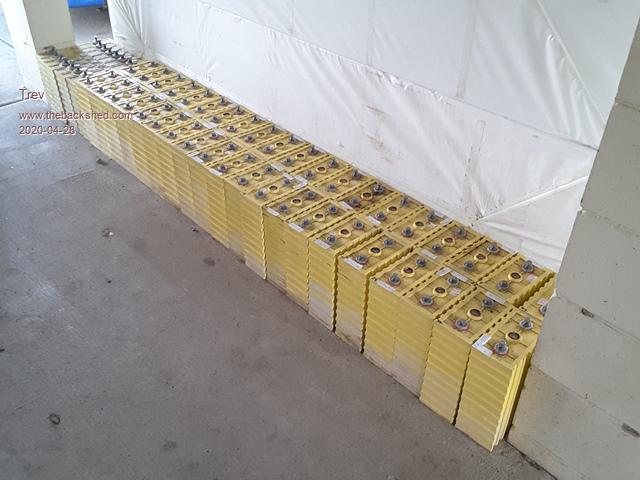 So that leads to a history check. This forum is a great diary to record all the important stuff. Don't get confused with this posting.....06 Apr 2008 The first pack bought for EV Hilux was sold but he wanted them tested before I sent them out. http://www.thebackshed.com/forum/ViewTopic.php?FID=15&TID=902 (hyper link not working, copy and past to check the reference) The pack we are talking about (second pack) was fitted to EV Hilux 21 Aug 2008. http://www.thebackshed.com/forum/ViewTopic.php?FID=15&TID=1127 And removed 25 June 2013 after doing 'Distance of original lithium pack is 437956 – 350153 = 87803 km. http://www.thebackshed.com/forum/ViewTopic.php?TID=5991 Then fitted to solar system (this thread, http://www.thebackshed.com/forum/ViewTopic.php?TID=6010 ) soon after but recorded 19 Aug 2013 and removed from service last week on 23 April 2020. That makes 11 years and 8 months old. Cycle life of LFP is said to be 2000-3000 cycles. These were cycled almost everyday, some days twice in the day in EV Hilux and everyday on the solar. As a guestimate... 11.67 years x 365 days = 4259 cycles. EV's are naturally hard on batteries, but I also pushed them in some ways. Got them hot (70C), put ice on them. Discharged very low very often. Sometimes over charged. On the solar we have the stand-alone inverter and 2 grid tie inverters. The grid inverters keep pumping power from the batteries down to around 80-90% out everyday. Pulling power through the stand-alone inverter never stops. The batteries are extremely low when the sun comes up. Most mornings cooked brekky still on the batteries, though some mornings we swapped back to grid to cook brekky, but then swapped back to batteries again. 12kW of solar has the potential of max charging rate of 240A. In EV Hilux discharge at full throttle is up to 1000A. Never had to use a generator. When the grid goes down the grid inverters don't work so have plenty of power stored in the batteries. Once I did use EV Hilux to power the house. There was a cyclone coming and looking at the tracking, thought to have another day before it hit, so let the battery power out to the grid. The cyclone hit that night, so then I switched to EV Hilux batteries for power. These LFP batteries as a pack at 48v still have around 80-90Ah, but we decided to retire them. They had around 300Ah as a 48v pack when fitted to the solar system. In EV Hilux they were all in series. If we did not have the grid inverters taking power from these batteries they would be good for a few more years yet. Ergon have been paying us over $2000 per year for exported power so it is worth updating the batteries to keep this export happening. Trev @ drivebynature.com |
||||
Trev Guru Joined: 15/07/2006 Location: AustraliaPosts: 640 |
The new pack is 900Ah 48v Thundersky Winston LYP. 3 parallel of 300Ah cells x 16 cells in series. The battery box is just big enough to house all 48 cells. Used 3 rows of 10mm thread on each side and the ply box end with steel angle as strapping. The cells must be strapped to stop them cells swelling in normal use. The second end of the box has no screws so can be moved as a clamp plate on the cells. Once the cells were clamp up, 1 screw was put in the top corners of the box sides to hold the box together. 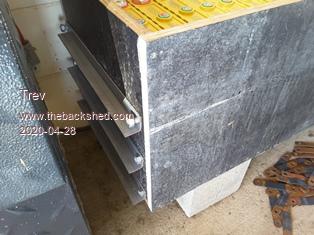 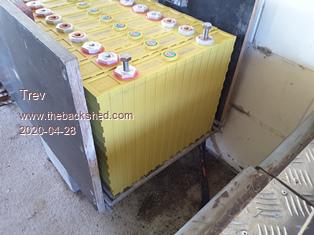 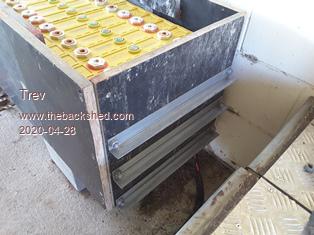  Cells all connected up as normal and charge from solar until the first cells reach 3.6-3.7v. Then all series connections are removed. All cells are connected in parallel and charged with 11 x 3.7v chargers until all cells are the same voltage.  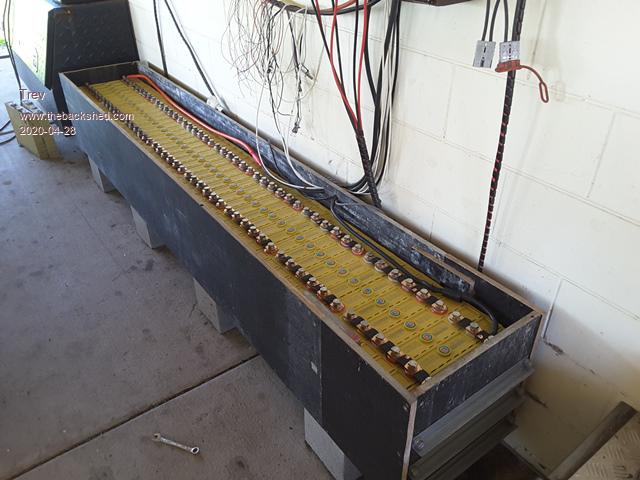 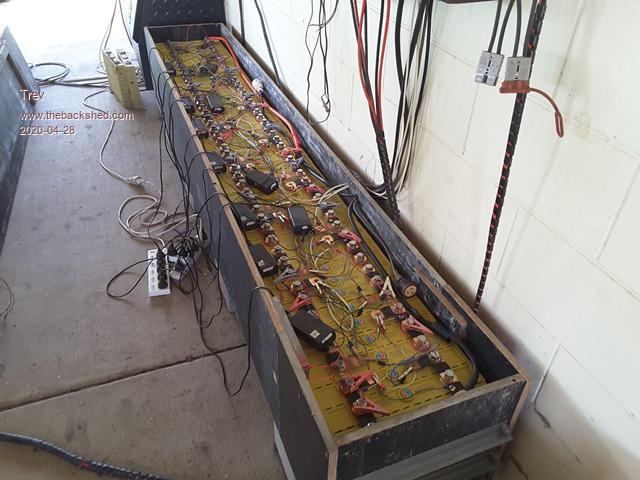 Then the parallel connections are removed and reconnected as normal (3P16S). It is great to see the battery power still going out to the grid after midnight. This morning checked at 2.30am and power was still going out to the grid. And still plenty of stored power to cook breakfast. In fact I could go to the shed and use the welder or metal lathe, milling machine or compressor before sun up if I wanted (the old batteries run all these things). Plenty of power. We have also seen the batteries full up again by lunch time every day so far. One day was even cloudy but still full by 1pm. Trev @ drivebynature.com |
||||
| Old Seagull Man Regular Member Joined: 21/12/2019 Location: AustraliaPosts: 55 |
Thanks Trev, for the information on life with Lithium. Are you still selling new battery's or is that long past. Also thanks for the idea. I have two old Pv edge 1250 inverters, im thinking i might connect 48 volts and see what output i get. The two units would give me about 2.4kw. That's more than most nights, grid, usage. |
||||
| Davo99 Guru Joined: 03/06/2019 Location: AustraliaPosts: 1578 |
How much were the new Batteries and what will you be doing with the old ones? |
||||
Trev Guru Joined: 15/07/2006 Location: AustraliaPosts: 640 |
having some trouble trying to post. so going to attempt smaller posts to see if it works. Yes I still sell them. Quite a few thousand kg per year, I sell. The biggest year so far sold around 10,000kg. About 6000kg currently in stock. 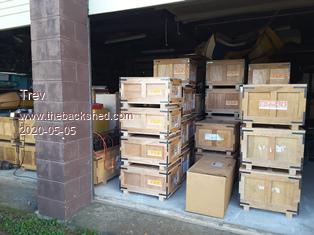 Trev @ drivebynature.com |
||||
Trev Guru Joined: 15/07/2006 Location: AustraliaPosts: 640 |
Well the smaller post uploaded, but the forum is back to giving me an error code again, even with smaller posts. I keep trying to post I sell a lot, but don't make much money on them, They cost a lot. A friend once said he was going to get them direct from the factory at a better prce, but by the time they landed in Australia it cost him $2.20 per Ah. This was at a time I was selling at $1.40 per Ah. It was a good US AU exchange rate back then. You have to be ordering big volume to be economical. Trev @ drivebynature.com |
||||
Trev Guru Joined: 15/07/2006 Location: AustraliaPosts: 640 |
going on from previous posts. I am also wondering if some other issue is stopping the posts as well. and i get tired from typing it all over agian. I generally order between 3000kg to 4000kg at a time. the biggest order so far was a few years ago, around 6000kg in one hit. Thats a lot of money. I have to order a lot at a time to keep the price down. The current US AU exchange rate is very bad which make the cost in Australia much higher. Cureent price for Thundersky Winston LYP is $1.86 per Ah. Our new solar system battery. 48 cells x 300Ah x $1.86 = $26784 79 copper connectors x $5 = $395 Plus strapping thread bar etc And initially, it will get 4 Deligreen balancers x $140 = $560. See how this goes. I had 12 balancers on the old pack. Thats a triple stack for 3 times the transfer rate. The LYP chemistry is the same as the LFP except it has the Yttrium added which increases the voltage stability and increases cycle life. The LYP is said to be 5000 to 7000 cycles compared to the LFP at 2000 to 3000 cycles. The battery pack in EV Hilux is LYP and are now 6 years and 8 months. The LFP were taken out of EV Hilux at 5 years but probably should have been 3 years. These LYP in EV Hilux were fitted when the old LFP were taken out. I am not expecting the full cycle life from the LYP in EV Hilux, EVs are hard on batteries compared to solar. Already at 6 years and 8 months is shown to be better. Plus I travel long distances, many times a year, with multiple cycles per day with this pack. A number of customers have reported after many years on solar, their LYP batteries are still performing like they were new. The old batteries, LFP, are a giveaway if anyone interested. The LYP are still worth a small dollar, any offers. The LYP are not as old. http://www.thebackshed.com/forum/ViewTopic.php?TID=2790&P=3 I did inquire about recycling. One place, Envirostream Australia, said they recycle lithium batteries, but i had to pay them, and pay the freight to Victoria. Freight is not cheap either. Trev @ drivebynature.com |
||||
Trev Guru Joined: 15/07/2006 Location: AustraliaPosts: 640 |
Old Seagull Man The PVE 1200 grid inverters require a 240vac on the output side to get them to switch on. You also need to swap some dip switches inside to make them run from a battery instead of running from a solar array. The PVE 1200 manual explains how to do this. Trev @ drivebynature.com |
||||
| Page 1 of 2 |
|||||